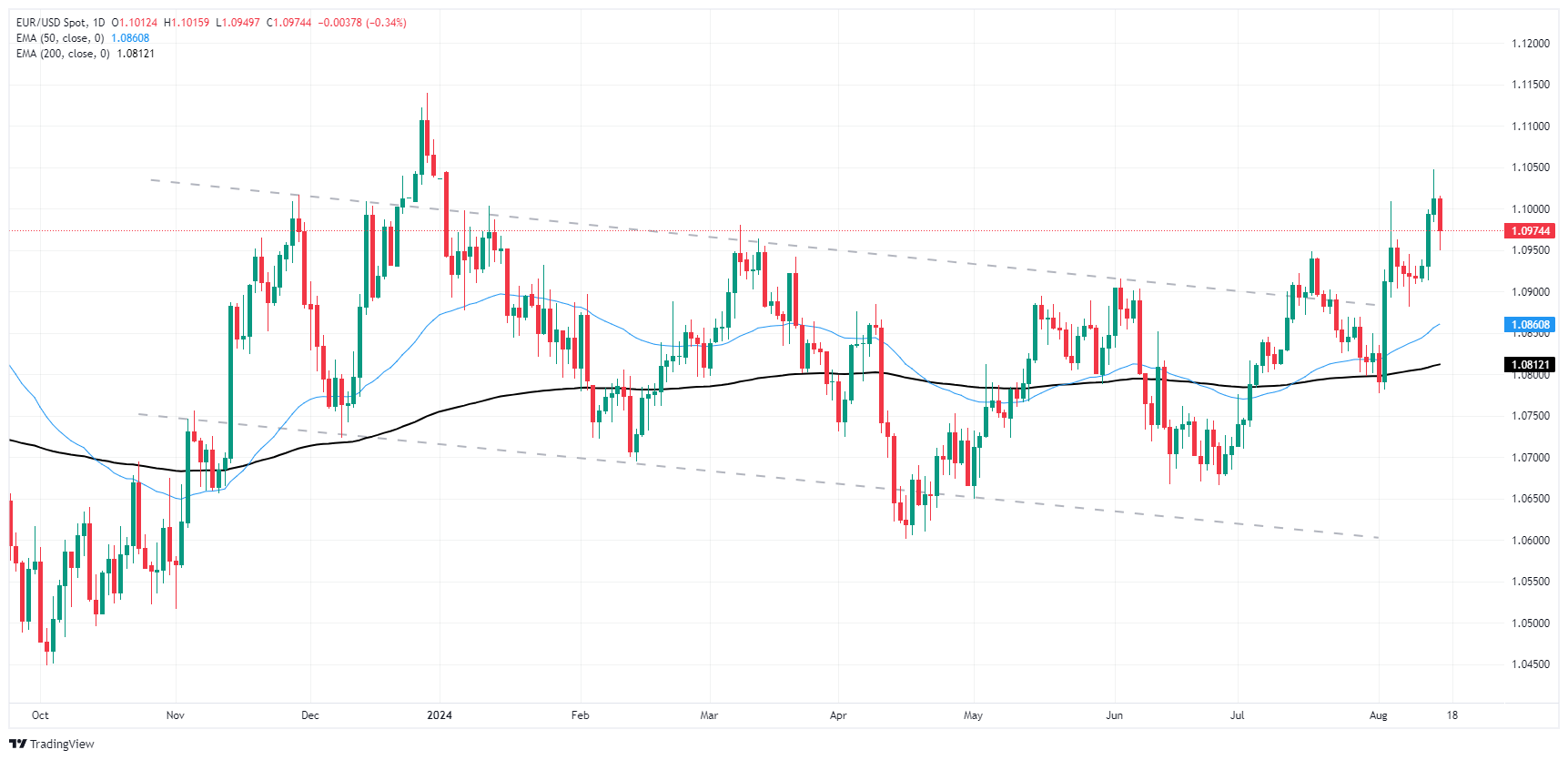EUR/USD blinks on Thursday, falls back below 1.1000

- EUR/USD pitched lower despite Thursday’s improved risk appetite.
- US Retail Sales climbed much higher than expected.
- US data to dominate the remainder of the trading week with consumer sentiment.
EUR/USD took a dive back below the 1.1000 handle on Thursday despite a broad-market recovery in investor sentiment. US Retail Sales growth lurched to an 18-month high of 1.0% MoM in July, well above the forecast 0.3% and entirely engulfing the previous month’s -0.2% contraction. Improving economic health indicators are helping to stave off recent concerns of a potential recession within the US.
However, not all is rosy in financial markets post-Retail Sales. According to the CME’s FedWatch Tool, rate markets are now pricing in just 25% odds of a 50 bps double cut from the Federal Reserve (Fed) in September, down significantly from last week’s peak bets of 70% odds. Rate traders have still fully priced in a September rate trim as a done deal, with 75% odds of at least 25 basis points off of the top on September 18.
US data will take center stage for Fiber traders on Friday, where the University of Michigan’s Consumer Sentiment Survey Index is expected to show an improvement in consumer economic expectations, with the figure forecast to tick up to 66.9 from an eight-month low of 66.4.
Economic Indicator
Michigan Consumer Sentiment Index
The Michigan Consumer Sentiment Index, released on a monthly basis by the University of Michigan, is a survey gauging sentiment among consumers in the United States. The questions cover three broad areas: personal finances, business conditions and buying conditions. The data shows a picture of whether or not consumers are willing to spend money, a key factor as consumer spending is a major driver of the US economy. The University of Michigan survey has proven to be an accurate indicator of the future course of the US economy. The survey publishes a preliminary, mid-month reading and a final print at the end of the month. Generally, a high reading is bullish for the US Dollar (USD), while a low reading is bearish.
Next release: Fri Aug 16, 2024 14:00 (Prel)
Frequency: Monthly
Consensus: 66.9
Previous: 66.4
Source: University of Michigan
EUR/USD price forecast
EUR/USD snapped a recent winning streak, tumbling back below the 1.1000 major handle on Friday. Bulls appear set to run out of gas and near-term momentum threatens to drag the Fiber back into a rough descending channel that has plagued the pair through 2024.
Bidders will be looking for technical support from a rising pattern of higher lows on daily candlesticks, but EUR/USD remains poised for a quick snap back toward the 200-day Exponential Moving Average (EMA) at 1.0826.
EUR/USD daily chart
Euro FAQs
The Euro is the currency for the 20 European Union countries that belong to the Eurozone. It is the second most heavily traded currency in the world behind the US Dollar. In 2022, it accounted for 31% of all foreign exchange transactions, with an average daily turnover of over $2.2 trillion a day. EUR/USD is the most heavily traded currency pair in the world, accounting for an estimated 30% off all transactions, followed by EUR/JPY (4%), EUR/GBP (3%) and EUR/AUD (2%).
The European Central Bank (ECB) in Frankfurt, Germany, is the reserve bank for the Eurozone. The ECB sets interest rates and manages monetary policy. The ECB’s primary mandate is to maintain price stability, which means either controlling inflation or stimulating growth. Its primary tool is the raising or lowering of interest rates. Relatively high interest rates – or the expectation of higher rates – will usually benefit the Euro and vice versa. The ECB Governing Council makes monetary policy decisions at meetings held eight times a year. Decisions are made by heads of the Eurozone national banks and six permanent members, including the President of the ECB, Christine Lagarde.
Eurozone inflation data, measured by the Harmonized Index of Consumer Prices (HICP), is an important econometric for the Euro. If inflation rises more than expected, especially if above the ECB’s 2% target, it obliges the ECB to raise interest rates to bring it back under control. Relatively high interest rates compared to its counterparts will usually benefit the Euro, as it makes the region more attractive as a place for global investors to park their money.
Data releases gauge the health of the economy and can impact on the Euro. Indicators such as GDP, Manufacturing and Services PMIs, employment, and consumer sentiment surveys can all influence the direction of the single currency. A strong economy is good for the Euro. Not only does it attract more foreign investment but it may encourage the ECB to put up interest rates, which will directly strengthen the Euro. Otherwise, if economic data is weak, the Euro is likely to fall. Economic data for the four largest economies in the euro area (Germany, France, Italy and Spain) are especially significant, as they account for 75% of the Eurozone’s economy.
Another significant data release for the Euro is the Trade Balance. This indicator measures the difference between what a country earns from its exports and what it spends on imports over a given period. If a country produces highly sought after exports then its currency will gain in value purely from the extra demand created from foreign buyers seeking to purchase these goods. Therefore, a positive net Trade Balance strengthens a currency and vice versa for a negative balance.
